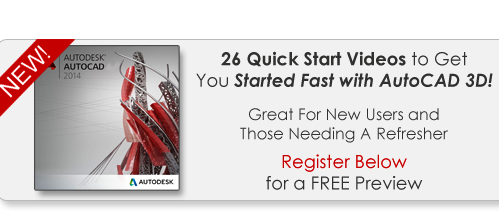Need To Learn AutoCAD In A Hurry?
We’ve trimmed the fat that other AutoCAD training courses use to ‘Fatten Up’ their tutorials to add content, our AutoCAD Video Tutorials cover everything you need to get started quickly. Guaranteed.
Chapter 01 – 2 Lessons
This chapter introduces 3D basics. Discussed first are the concepts of axes, planes and faces, followed by the 3D drafting/modeling tools including toolbars, workspaces and the 3D Ribbon. How to enter and exit 3D is discussed next, as well as how to project into 3D via rotation of the UCS icon. Extrude is introduced next as the primary 3D tool. Dynamic views are discussed next, as well as various visual styles such as shade and hide. The chapter concludes with the introduction of the ViewCube and Navigation Bar.
Chapter 02 – 3 Lessons
This chapter introduces a wide variety of 3D tools needed for basic construction. Discussed is Rotate3D, 3D Rotate (with Gizmo), Mirror 3D, 3D Array, 3D Scale, 3D Move, and fillet/chamfer in 3D. The chapter features two projects, a 3D chair and bookshelf.
Chapter 03 – 2 Lessons
This chapter introduces Boolean Operations (Union, Subtract, Intersect) that allow for complex interaction between 3D pieces. The chapter features a 3D drawing project of a wall with a door and a window. Next the chapter moves on to introducing the basic primitives shapes (Box, Wedge, Cone, Sphere, Cylinder, Torus, Pyramid) and presents some applications.
Chapter 04 – 4 Lessons
This chapter introduces advanced “curved design” tools (Revolve, Shell, Taper, Loft, Path Extrusion and Sweep). Applications and examples are included as needed. This chapter features a small 3D modeling project of a tapered, shelled and filleted wastebasket.
Chapter 05 – 2 Lessons
This chapter continues where the previous one left off and introduces more advanced 3D design tools (Polysolid, Helix, 3D Path Array, and working with Faces and Edges).
Chapter 06 – 2 Lessons
This chapter introduces legacy surfaces such as Planar Surface, Region, Rulesurf, Tabsurf, Revsurf, Edgesurf and 3D face and mesh. It then continues on to more recently introduced tools such as Smooth Mesh Primitives, Mesh Smoothing, Face Move and Rotate, Collapse Face or Edge, Convert Solid to Surface and Section Planes.
Chapter 07 – 3 Lessons
This chapter introduces and covers the concepts of sectioning and presenting views. Included are the two basic approaches called slice and section. Then a variety of view creation concepts are covered for purposes of making 2D views from 3D models. Included are Base, Projected, Section, and Detail views. The chapter concludes with additional layout options and Flatten/Flatshot, used to make flat images from 3D models. The final topic is the concept of Vports.
Chapter 08 – 2 Lessons
This chapter elaborates further on the UCS tool first seen in Chapter 21. Advanced UCS techniques are discussed such as 3 Point UCS placement as well as view presets. Text and Dimensioning in 3D is also touched upon. This chapter features and advanced modeling project of a racing car suspension.
Chapter 09 – 4 Lessons
This chapter introduces advanced Dview options, working with Cameras, Walk and Fly navigation, and Path Animation.
Chapter 10 – 2 Lessons
This chapter introduces the basics of lighting (Spotlight, Point Light, etc) and shadows. It then moves on to the Sun and Sky concept, Material Applications and Rendering.
Information about delivery of the AutoCAD 3D Tutorials.








0 komentar:
Post a Comment